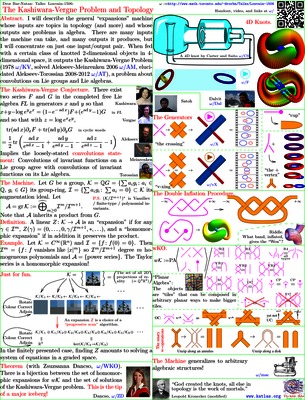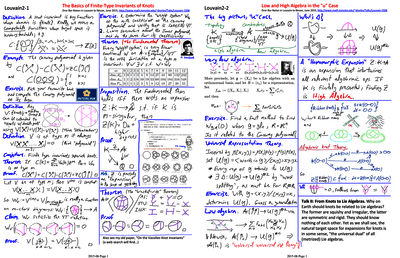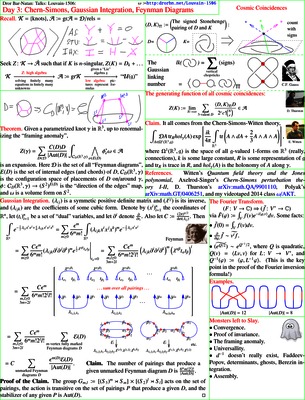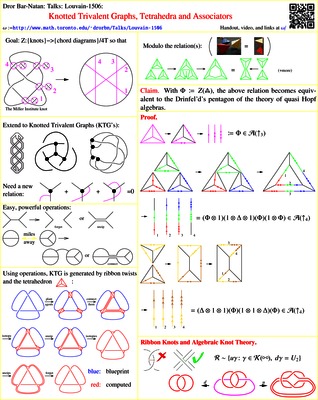© | << < ? > >> |
Dror Bar-Natan:
Talks:
Expansions
Five Chaire de
la Vallée-Poussin talks in Louvain-la-Neuve, Belgium, June 1-5,
2015.
Links:
AKT
AM
AT
Bern
CS
Dal
F
inf
KBH
KV
mac
vX
WKO
WKO1
WKO2
X
ZD
|
Abstract. It is less well known than it should be, that the
standard notion of an expansion of a smooth function on a Euclidean space
into a power series ("the Taylor expansion") is vastly more general than
it first seems; in fact, it is almost ridiculously more general. In my
series of talks I will concentrate on expansions for knotted objects in 3
and 4 dimensions, on how these expansions relate these objects to problems
in Lie theory, and on how these expansions may be constructed using
tools from quantum field theory (which in themselves are "expansions").
Source Files: pensieve.
|
Talk I: The Kashiwara-Vergne Problem and Topology.
I will describe the general "expansions" machine
whose inputs are topics in topology (and more) and whose outputs are
problems in algebra. There are many inputs the machine can take, and many
outputs it produces, but I will concentrate on just one input/output
pair. When fed with a certain class of knotted 2-dimensional objects
in 4-dimensional space, it outputs the Kashiwara-Vergne Problem (1978,
solved Alekseev-Meinrenken 2006, elucidated Alekseev-Torossian 2008-2011),
a problem about convolutions on Lie groups and Lie algebras.
This will be an overview talk: you do not need to know what the
Kashiwara-Vergne problem is in order to understand this talk, nor do you
have to have seen a 2-knot before, and most details will await further
discussion in the later talks.
Handout. Louvain1.html,
Louvain1.pdf.
Talk Video. 
Papers. WKO1.pdf, WKO2.pdf.
Talk II: From Knots to Lie Algebras. Why on Earth should
knots be related to Lie algebras? The former are squishy and irregular,
the latter are symmetric and rigid. They should know nothing of each
other. Yet as we shall see, the natural target space for expansions
for knots is in some sense, "the universal dual" of all (metrized)
Lie algebras.
Handout. Louvain2.html,
Louvain2.pdf.
Talk Video. 
Talk III: Chern-Simons Theory and Feynman Diagrams. We will
study Feynman diagrams in ${\mathbb R}^n$ and then apply the techniques
we will have learned to the case of the infinite-dimensional Chern-Simons
path integral. The result $Z^u$ will be an expansion for knots, or a
"universal finite type invariant".
Handout. Louvain3.html,
Louvain3.pdf.
The back side. Portfolio.
Talk Video. 
Talk IV: Knotted Trivalent Graphs and Associators. We will
find that in order to compute our expansion $Z^u$ on arbitrary knots,
it is enough to compute or guess its value on just one specific knotted
trivalent graph - the unknotted tetrahedron in ${\mathbb R}^2$. This, it turns out, is precisely what is
called "a Drinfel'd associator".
Handout. Louvain4.html,
Louvain4.pdf.
The back side. Infrastructure.
Talk Video. 
Talk V: Back to 4D. We will repeat the 3D story of the previous
3 talks one dimension up, in 4D. Surprisingly, there's more room in
4D, and things get easier, at least when we restrict our attention to
"w-knots", or to "simply-knotted 2-knots". But even then there are
intricacies, and we try to go beyond simply-knotted, we are completely
confused.
Handout. Louvain5.html,
Louvain5.pdf.
Talk Video. 







